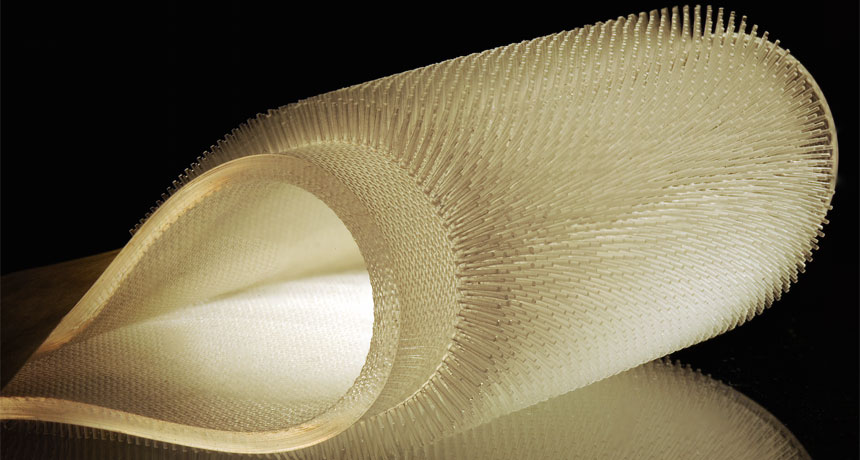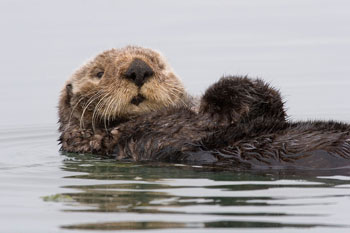Wet suits with hair?
New material could inspire textiles that mimic air-trapping otter fur

This rubber sheet covered with a forest of stubby structures could some day inspire “hairy” fabrics that provide air-trapping insulation on wet suits for cold-water divers.
Felice Frankel
By Sid Perkins
Otters are amazingly cute, no doubt. But these marine mammals also are amazing in another way. Although they often swim in waters that are 16° Celsius (61° Fahrenheit) or colder, they can maintain a warm body temperature of about 38 °C (100 °F). And they keep their body heat even without an insulating layer of blubber like whales, seals and sea lions. Now engineers are taking a clue from those otters. And one long-term end product may be hairy wet suits for people who dive in cold waters.

Some researchers are studying surfaces covered with forests of stubby rods that one day might lead to fur-inspired fabrics. Yes, furry wet suits. They’re not there yet. For now, they’re learning things that can help manufacturers and engineers today.
On the surface
The roughness of a surface affects how well water soaks into it. So does its chemical recipe. Scientists have long studied those properties. And they have analyzed the effects of small bumps and tiny ridges. But few teams have studied how flexible structures such as hair affect a material’s ability to repel water, says Alice Nasto. She’s a mechanical engineer at the Massachusetts Institute of Technology in Cambridge. (A mechanical engineer is someone who uses physics and materials science to design, develop, build and test mechanical devices.)
Recently, Nasto and her co-workers took the first steps toward such fur-ish designs. They were inspired by how the dense fur of otters and fur seals help trap air next to the creatures’ skins. They were also inspired by the opportunity to help fill in gaps in basic knowledge in this area, says Nasto. For example: Could large-scale structures on a surface help increase its water repellence as well as tiny bumps and ridges do?
Answering that question, she notes, could help engineers solve a number of problems. They could come up with different techniques, for example, to boost how well a surface could resist getting soaked.
As a first step, the team probed how water repellent surfaces become when they’re covered with stiff, stubby structures. First, they used lasers to sculpt molds with hundreds of tubular holes. Then they filled those molds with a liquid rubber-like silicone. The silicone filled the holes and then flowed over the tops of them. That created stub-covered sheets when the material gelled. Finally, Nasto’s team dipped those rubber sheets into a container of water and watched what happened. The more slowly the water soaked into the forest of stubs and replaced the air trapped there, the more water repellent the surface was considered to be.
In its lab tests, the team studied the effects of changing the material’s properties. For example, they altered the size of the stubby structures and the distances between them. The researchers also studied the effect of dipping the surfaces into the water quickly instead of slowly.
They found that the longer and more closely spaced the structures were, the more time it took water to soak in. And plunging the surfaces into the water quickly trapped air for a longer time. Still, each of the surfaces eventually got soaked all the way through.
Nasto presented her team’s findings on November 23 in Boston, Mass., at the annual meeting of the American Physical Society’s division of fluid dynamics.
The team’s results “are very interesting and could be very useful,” says José Bico, who was not involved in the research. He works at the City of Paris Industrial Physics and Chemistry Higher Educational Institution in France. There, he studies fluid mechanics. That includes how liquids and gases flow under pressure.
The new findings could help engineers who design oddly shaped structures like car radiators, he notes. (Those devices have many flat, closely spaced surfaces, called fins, that radiate heat to cool a vehicle’s engine.) Manufacturers often dip such equipment into rustproofing liquids. But if the object isn’t held beneath the liquid long enough, the liquid doesn’t completely soak in. And when that happens, the equipment is more vulnerable to rust. The new data might offer engineers a better idea of how long a piece of equipment needs to be submerged for it to get a full coating of rustproofing liquid, Bico suggests.
Learning from otters
In the future, Nasto and her co-workers plan to study surfaces studded with longer and more flexible structures that better mimic hair. That research might answer several questions. For instance, how long, flexible and dense do the “hairs” have to be for them to create a fake fur that can trap air really well?
People looking to design such structures could learn a few things from otters, says Heather Liwanag. She’s a marine biologist at California Polytechnic State University in San Luis Obispo. She studied otter fur when she was earning her PhD at the University of California, Santa Cruz.
For one thing, Liwanag notes, the longer and coarser hairs in an otter’s fur don’t have a circular cross section. Those hairs, called guard hairs, are oval. That shape helps them lay down in a consistent direction when they’re wet. Also, the hairs have tiny scalelike features on them. That helps the hairs lock together. That makes a flexible shell that locks out water and locks in air.
“Without its air-trapping layer of fur, an otter would need a layer of blubber so thick it would end up the size of a seal,” notes Liwanag.
Power Words
(for more about Power Words, click here)
blubber The thick layer of fat under a marine mammal’s skin that helps it stay warm even in cold waters. In the past, whalers would boil whale blubber to extract oil, which had many industrial uses.
engineer A person who uses science to solve problems. As a verb, to engineer means to desiogn a device, material or process that will solve some problem or unmet need.
fluid mechanics The study of the properties of fluids (liquids and gases) and their reactions to the forces acting upon them under various conditions.
guard hairs The longer and coarser (or stiffer) hairs that form the outer layer of a mammal’s fur (if that fur is layered).
laser A device that generates an intense beam of coherent light of a single color. Lasers are used in drilling and cutting, alignment and guidance, in data storage and in surgery.
mammal A warm-blooded animal distinguished by the possession of hair or fur, the secretion of milk by females for feeding the young, and (typically) the bearing of live young.
marine Having to do with the ocean world or environment.
marine biologist A scientist who studies creatures that live in ocean water, from bacteria and shellfish to kelp and whales.
mechanical Having to do with the devices that move, including tools, engines and other machines.
mechanical engineer Someone who uses physics and materials science to design, develop, build and test mechanical devices, including tools, engines and other machines.
PhD (also known as a doctorate) A type of advanced degree offered by universities — typically after five or six years of study — for work that creates new knowledge. People qualify to begin this type of graduate study only after having first completed a college degree (a program that typically takes four years of study).
radiate (in physics) To emit energy in the form of waves.
scuba diving A form of underwater diving in which the person carries special equipment in order to breathe, including a tank of air and a breathing mask. The word scuba is short for self-contained underwater breathing apparatus.
sea otter A member of the weasel family, sea otters have the densest fur known among animals. That helps keep them warm in frigid waters, because these marine mammals don’t produce blubber — a thick layer of fat — as do seals and walruses.
silicone Heat-resistant substances that can be used in many different ways, including the rubber-like materials that provide a waterproof seal around windows and in aquariums. Some silicones serve as grease-like lubricants in cars and trucks. Most silicones, a type of molecule known as a polymer, are built around long chains of silicon and oxygen atoms.
water repellency A material’s ability to repel water.
whale A common, but fairly imprecise, term for a class of large mammals that lives in the ocean. This group includes dolphins.
wet suit An outer rubber or rubber-like suit worn over the body (including arms and legs) when swimming in cold water. It helps preserve body heat and limit other risks to the skin of divers.
This is the first in a series presenting news on invention and innovation, made possible with generous support from the Lemelson Foundation.







